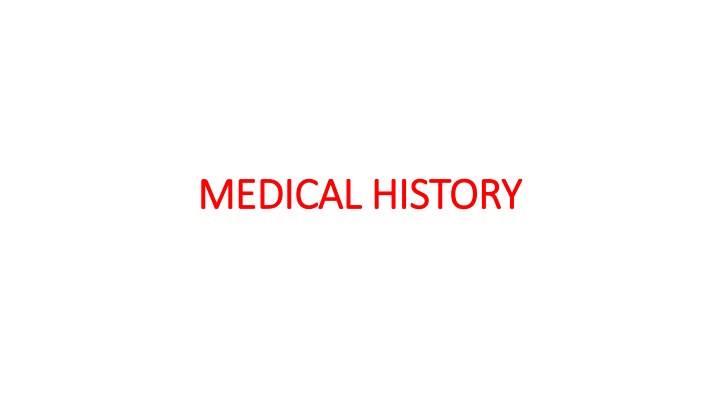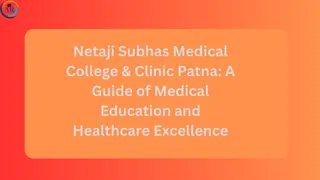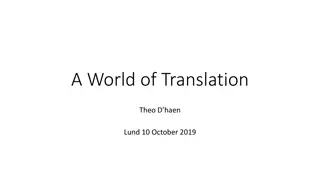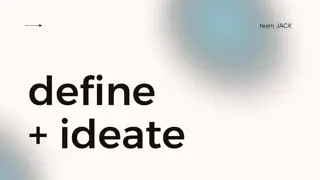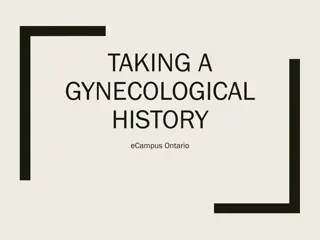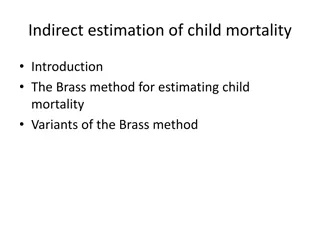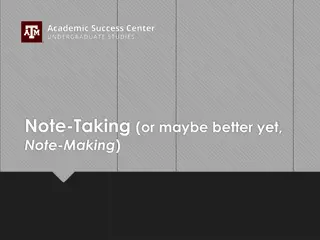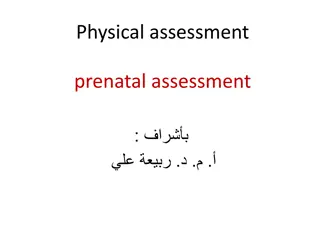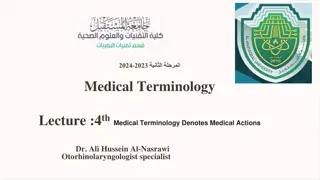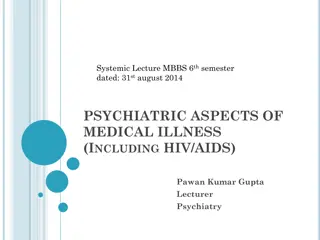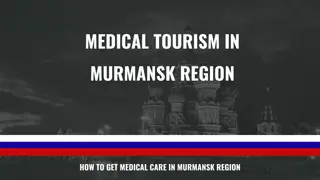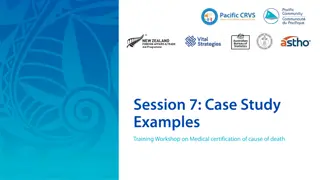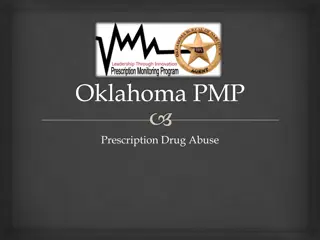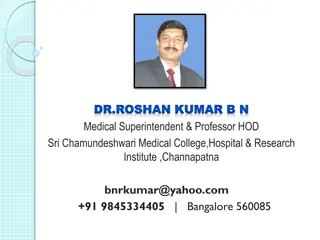Guide to Taking Medical Histories
As a medical professional, collecting detailed medical histories is crucial for diagnosing and treating patients effectively. Learn how to gather information on past medical issues, social habits, family medical history, and more in this comprehensive guide.
Download Presentation

Please find below an Image/Link to download the presentation.
The content on the website is provided AS IS for your information and personal use only. It may not be sold, licensed, or shared on other websites without obtaining consent from the author.If you encounter any issues during the download, it is possible that the publisher has removed the file from their server.
You are allowed to download the files provided on this website for personal or commercial use, subject to the condition that they are used lawfully. All files are the property of their respective owners.
The content on the website is provided AS IS for your information and personal use only. It may not be sold, licensed, or shared on other websites without obtaining consent from the author.
E N D
Presentation Transcript
MEDICAL HISTORY MEDICAL HISTORY
Guide to taking medical histories As a medical professional, you should be prepared to take through medical histories. The data you collect reveals important details about a patient. Doctors use these details to uncover likely causes of medical conditions and establish diagnoses. First, get as many details as possible about a patient s complaints. Find out if the patient has a history of the condition. Ask when the patient experienced the onset of symptoms. Check what makes it worse and makes it better. Then, find out about the patient s past medical history. Record any previous medical problems, especially those that could relate to the current condition. Other details can also contribute to a useful medical history. A good social history includes information about the patient s personal habits and lifestyle. A family medical history reveals conditions that are more likely to occur in a particular family. Before any medical procedure, make sure you have an updated record of the patient s allergies. This way, you avoid exposing patients to medications or substances that might harm them.
Activity1: Read the guide to taking medical histories. Then complete the table using information from the table. Type o history Information included Past medical history Social history Family medical history
Activity 2: Match the words with definitions 1- data 4-complaint 2- onset 3- allergy 5- procedure 6- family medical history a- The first instance of something. b- A record of a patient s family condition. c- A collection of information. d- A condition that causes reaction or illness. e- A medical treatment. f- A pain or illness reported by a patient.
Activity 3: Choose where the word best fits History of; social history; current ; past medical history 1) Paul s family has a cancer. 2) The patient s condition was caused by a recent injury. 3) The patient s included her previous surgery. 4) The patient s included her occupation.
Activity 3: Choose where the word best fits History of; social history; current ; past medical history 1) Paul s family has a history of cancer. 2) The patient s current condition was caused by a recent injury. 3) The patient s past medical history included her previous surgery. 4) The patient s social history included her occupation.
Activity: Formulate 3 questions to get information about: - Past medical history - History of the condition - Social history - Family medical history
MAINTINING HYGIENE MAINTINING HYGIENE
From: Bernard Kabore Hospital director To: All staff Sent: Sat, Nov 15 Subject: Hygiene standards Attention hospital staff: The flu season is approaching. I want to remind everyone of the importance of maintaining strict hygiene standards. Contagious new virus strains and drug resistant bacteria cause problems every year. I do not want that happening here. Regular handwashing with antimicrobial soap is imperative. All surfaces must be cleaned with disinfectant according to the maintenance schedule . We must always store antibiotic drugs in the proper cabinets. Biohazards should be mindful dispose of. Should drug resistant flu strains appear. We must quarantine all infected persons. To avoid transmitting further infections, no one will be allowed in quarantine areas without a facemask. Thank you for your help Bernard Kabore Hospital Director
Activity: Choose the correct answers 1) What is the purpose of the email? a- to promote the use of antibiotics drugs. b- to limit the use of antimicrobial soap. C-to remind the staff about hygiene standards. d- to announce a new maintenance schedule. 2) Which of the following is not recommanded by the director? a- handwashing with antimicrobial soap. b- quarantining infected individuals. c- storing biohazards in proper cabinets. d- cleaning surfaces with desinfectant.
3) What is required to enter quarantine areas? a- a facemask b- antimicrobial soap c- desinfectant d- antibiotics drugs
Activity: Match the words ( 1- 7) with the definitions (A-G) 1- infection; 2- facemask ; 3- quarantine; 4- bacteria; 5- transmit; 6- antibiotic; 7-contagious A. To relay an illness from one person to another. B. Singled celled organisms responsible for many human infections C. A manifestation of parasitic micro-organisms in the body D. A covering worn over the mouth and nose E. To isolate an individual to prevent transmission of microbes F. Something that kills bacteria in the body G. Moving easily from one person to another
Activity: Match the words ( 1- 7) with the definitions (A-G) 1- infection; 2- facemask ; 3- quarantine; 4- bacteria; 5- transmit; 6- antibiotic; 7-contagious A. To relay an illness from one person to another./5 B. Singled celled organisms responsible for many human infections/ 4 C. A manifestation of parasitic micro-organisms in the body/1 D. A covering worn over the mouth and nose/ 2 E. To isolate an individual to prevent transmission of microbes/3 F. Something that kills bacteria in the body/6 G. Moving easily from one person to another/ 7
Activity: Choose where the words best fit the blanks 1- antimicrobial/ biohazard A. Dr Tall washed his hand with an . soap B. The used syringes are 2- virus/ desinfectant A. Daniel cleaned the counters with B. The quarantined man did not transmit the . to anyone.
Activity :Complete the dialogue with: anything else; facemask; give it; a day or two, highly contagious; antimicrobial; - Doctor: Well Mr. Ky, You have a cold. It s a fairly common strain. You should recover in 1 . - Patient: Okay, I hope I don t 2 .. to my grand-daughter. - Doctor : It s a 3 illness. Do you live in the same house? - Patient : Yes, she s visiting for the holidays. - Doctor : Well, make sure to wash your hands regularly. And use 4 soap. - Patient : I will. Is there 5 . I can do? - Doctor: You could wear a 6 . for a few days . I ll give you a few to take home.
Communicating with patients and families
1) What are some possible causes of miscommunication with patients? 2) How can medical professionals improve communication with patients?
Nurses, as you know, clear communication is vital to providing the best care possible. However. it seems that as of late, we are not getting all the information we need. If you suspect you are not getting enough information from a patient, remember some of the possible causes of such miscommunication; Poor Health Literacy - Uninformed patients may not understand key terms. Negative Preconceptions - Patients may not trust medical professionals or may experience anxiety. Cultural Differences - Different cultures may have different approaches to dealing with iIIness If you recognize any of these issues, a few simple steps can be taken to help improve communication; Establish a good rapport. It's very important to the therapeutic process. Show empathy: Be aware of how your verbal and non-verbal cues affect the interaction Don't use too much jargon, since this may confuse or intimidate your patient Ask open ended questions to help signal to patients that you care about their input. Remember, you are our first and most important line of communication to patients. The more information we can give and receive, the better care we can provide
Activity 1: Match the words with the definitions: health literacy- miscommunication- verbal- empathy - cultural differencies - preconception 1) Different behaviours in different societies 2) The ability to relate to other people s feelings 3) Related to the use of spoken language 4) The ability to understand health information 5) An assumption 6) A mistake in an exchange of information
Activity2: Fill the blanks with empathy- improve-communication- jargon- confuse-trust-health He believes that clear 1 is necessary to provide good care. They suggest that misscommunication can occur due to poor 2 . literacy or a patient may not 3 doctos and nurses. To help 4 . communication, nurses should show 5 ..They also should limit their use of 6 because this might 7 . the patient.
Activity3: Choose the word that is closest in meaning to the underlined part. A. Jargon ; B. open-ended questions ; C. non-verbal ; D, therapeutic; E. Rapport. F. Anxiety 1- Gina asks her patient about his day to develop a connection 2- Some patients say music is helpful for healing or feeling relaxed. 3 - The nurse is using too much specialized vocabulary. 4 - Hospitals can cause feelings of nervousness and worry. 5 - Ask more Questions that require answers longer than one-word responses. 6- Frowning is a type of communication that is done without the use of spoken language.
READING TECHNIQUE Reading for main idea: By reading for the main ideas, you identify the point of view of the author- that is what the author s thesis is. Specifically, what does the author propose to write about the topic? If you could reduce the reading to one sentence, what would it be? The main idea usually occurs at the beginning of a reading passage Questions about main ideas can be worded in many ways. For example, the following questions are all asking for the same information: 1)What is the main idea? 2)What is the subject? 3)What would be a good title? Half of the population in Burkina Faso is under the age of 15. Many of these young people will become sexually experienced in their teens and, thus, will be at risk of or experience an unplanned pregnancy or a sexually transmitted infection (STI), including HIV/AIDS. To minimize these risks and secure a healthy future for adolescents, it is necessary that policymakers, journalists, service providers and advocates have solid evidence regarding the sexual and reproductive health needs of Burkinab youth. This Research in brief documents what is known about Burkinab adolescents sexual and reproductive health behaviors and needs, with particular emphasis on HIV/AIDS, and points the way forward toward improving policies and programs.
